CADILLAC STS 2011 1.G Owners Manual
Manufacturer: CADILLAC, Model Year: 2011, Model line: STS, Model: CADILLAC STS 2011 1.GPages: 528, PDF Size: 4.96 MB
Page 441 of 528
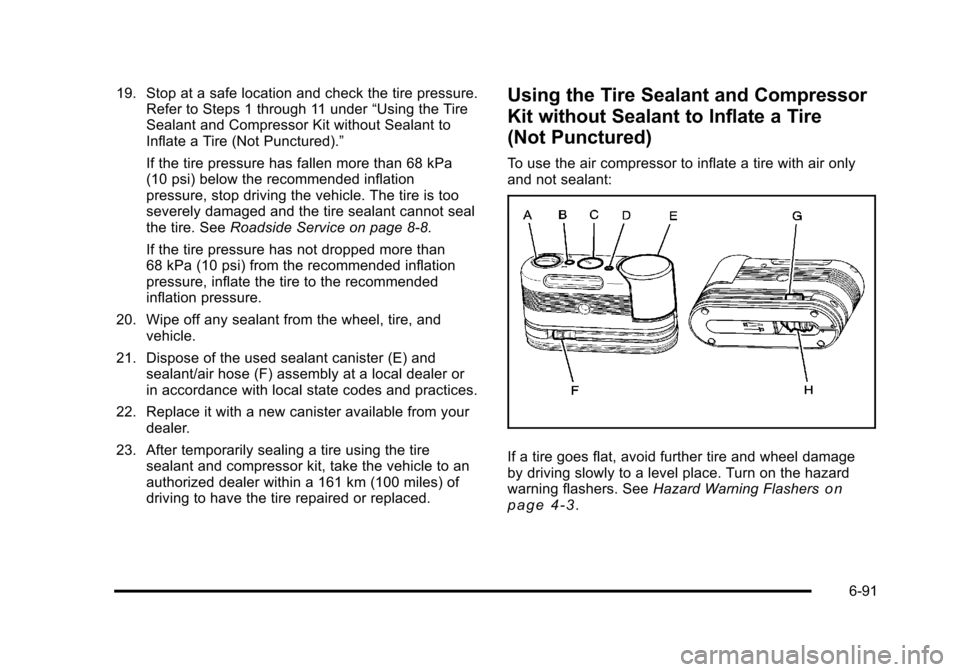
Black plate (91,1)Cadillac STS Owner Manual - 2011
19. Stop at a safe location and check the tire pressure.Refer to Steps 1 through 11 under “Using the Tire
Sealant and Compressor Kit without Sealant to
Inflate a Tire (Not Punctured).”
If the tire pressure has fallen more than 68 kPa
(10 psi) below the recommended inflation
pressure, stop driving the vehicle. The tire is too
severely damaged and the tire sealant cannot seal
the tire. See Roadside Service on page 8‑8.
If the tire pressure has not dropped more than
68 kPa (10 psi) from the recommended inflation
pressure, inflate the tire to the recommended
inflation pressure.
20. Wipe off any sealant from the wheel, tire, and vehicle.
21. Dispose of the used sealant canister (E) and sealant/air hose (F) assembly at a local dealer or
in accordance with local state codes and practices.
22. Replace it with a new canister available from your dealer.
23. After temporarily sealing a tire using the tire sealant and compressor kit, take the vehicle to an
authorized dealer within a 161 km (100 miles) of
driving to have the tire repaired or replaced.Using the Tire Sealant and Compressor
Kit without Sealant to Inflate a Tire
(Not Punctured)
To use the air compressor to inflate a tire with air only
and not sealant:
If a tire goes flat, avoid further tire and wheel damage
by driving slowly to a level place. Turn on the hazard
warning flashers. See Hazard Warning Flashers
on
page 4‑3.
6-91
Page 442 of 528

Black plate (92,1)Cadillac STS Owner Manual - 2011
SeeIf a Tire Goes Flaton page 6‑74for other
important safety warnings.
1. Remove the tire sealant and compressor kit from its storage location. See Tire Sealant and
Compressor Kit Storage on page 6‑94.
2. Unwrap the air only hose (G) and the power plug (H).
3. Place the kit on the ground.
4. Remove the tire valve stem cap from the flat tire by turning it counterclockwise.
5. Attach the air only hose (G) onto the tire valve stem by turning it clockwise until it is tight.
6. Plug the power plug (H) into the accessory power outlet in the vehicle. Unplug all items from other
accessory power outlets. See Accessory Power
Outlet(s) on page 4‑42.
If the vehicle has an accessory power outlet, do
not use the cigarette lighter.
If the vehicle only has a cigarette lighter, use the
cigarette lighter.
Do not pinch the power plug cord in the door or
window.
7. Start the vehicle. The vehicle must be running while using the air compressor.
8. Turn the selector switch (A) clockwise to the Air Only position. 9. Press the on/off (B) button to turn the
compressor on.
The compressor will inflate the tire with air only.
10. Inflate the tire to the recommended inflation pressure using the pressure gauge (C). The
recommended inflation pressure can be found on
the Tire and Loading Information label. See
Inflation - Tire Pressure on page 6‑58.
The pressure gauge (C) may read higher than the
actual tire pressure while the compressor is on.
Turn the compressor off to get an accurate
reading. The compressor may be turned on/off until
the correct pressure is reached.
If you inflate the tire higher than the recommended
pressure you can adjust the excess pressure by
pressing the pressure deflation button (D) until the
proper pressure reading is reached. This option is
only functional when using the air only hose (G).
11. Press the on/off button (B) to turn the tire sealant and compressor kit off.
Be careful while handling the tire sealant and
compressor kit as it could be warm after usage.
12. Unplug the power plug (H) from the accessory power outlet in the vehicle.
13. Disconnect the air only hose (G) from the tire valve stem, by turning it counterclockwise, and replace
the tire valve stem cap.
6-92
Page 443 of 528

Black plate (93,1)Cadillac STS Owner Manual - 2011
14. Replace the air only hose (G) and the powerplug (H) and cord back in its original location.
15. Place the equipment in the original storage location in the vehicle.
The tire sealant and compressor kit has an accessory
adapter located in a compartment on the bottom of its
housing that may be used to inflate air mattresses,
balls, etc.
Removal and Installation of the Sealant
Canister
To remove the sealant canister:
1. Unwrap the sealant hose.
2. Press the canister release button.
3. Pull up and remove the canister.
4. Replace with a new canister which is available from your dealer.
5. Push the new canister into place.
6-93
Page 444 of 528
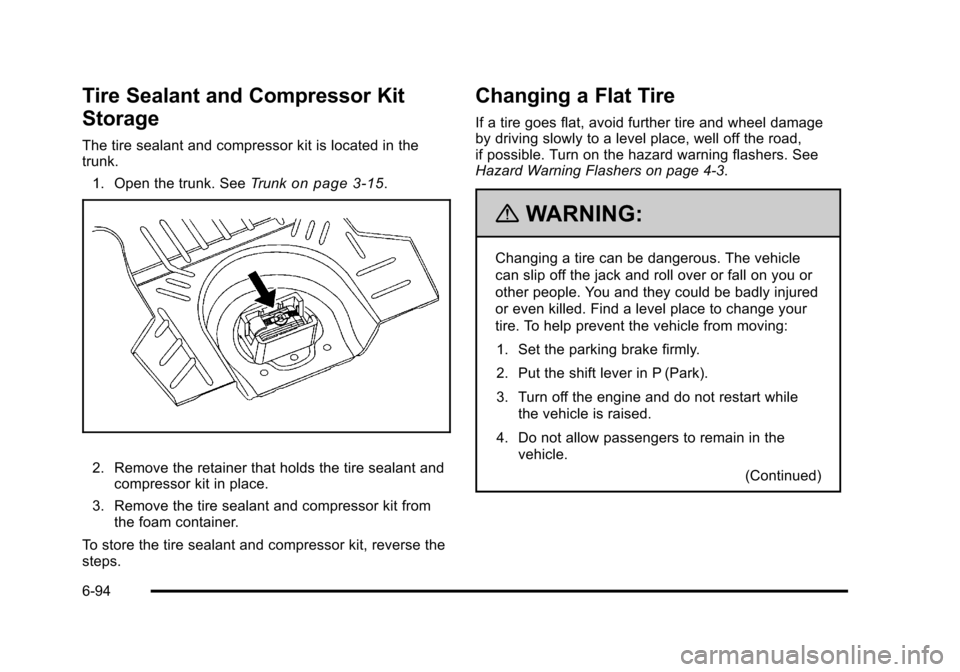
Black plate (94,1)Cadillac STS Owner Manual - 2011
Tire Sealant and Compressor Kit
Storage
The tire sealant and compressor kit is located in the
trunk.1. Open the trunk. See Trunk
on page 3‑15.
2. Remove the retainer that holds the tire sealant and
compressor kit in place.
3. Remove the tire sealant and compressor kit from the foam container.
To store the tire sealant and compressor kit, reverse the
steps.
Changing a Flat Tire
If a tire goes flat, avoid further tire and wheel damage
by driving slowly to a level place, well off the road,
if possible. Turn on the hazard warning flashers. See
Hazard Warning Flashers on page 4‑3.
{WARNING:
Changing a tire can be dangerous. The vehicle
can slip off the jack and roll over or fall on you or
other people. You and they could be badly injured
or even killed. Find a level place to change your
tire. To help prevent the vehicle from moving:
1. Set the parking brake firmly.
2. Put the shift lever in P (Park).
3. Turn off the engine and do not restart while the vehicle is raised.
4. Do not allow passengers to remain in the vehicle.
(Continued)
6-94
Page 445 of 528
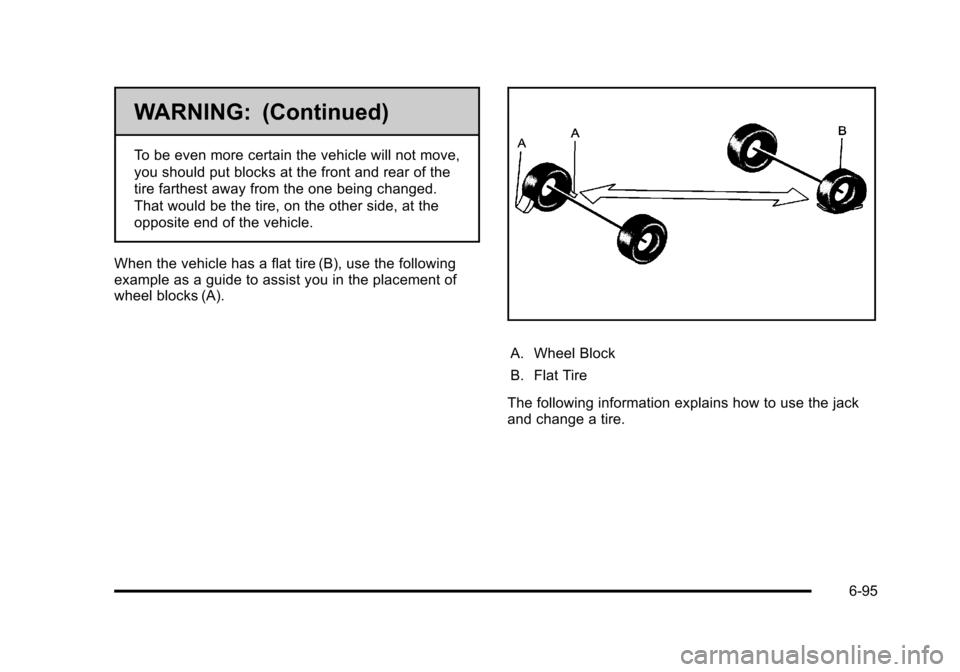
Black plate (95,1)Cadillac STS Owner Manual - 2011
WARNING: (Continued)
To be even more certain the vehicle will not move,
you should put blocks at the front and rear of the
tire farthest away from the one being changed.
That would be the tire, on the other side, at the
opposite end of the vehicle.
When the vehicle has a flat tire (B), use the following
example as a guide to assist you in the placement of
wheel blocks (A).
A. Wheel Block
B. Flat Tire
The following information explains how to use the jack
and change a tire.
6-95
Page 446 of 528
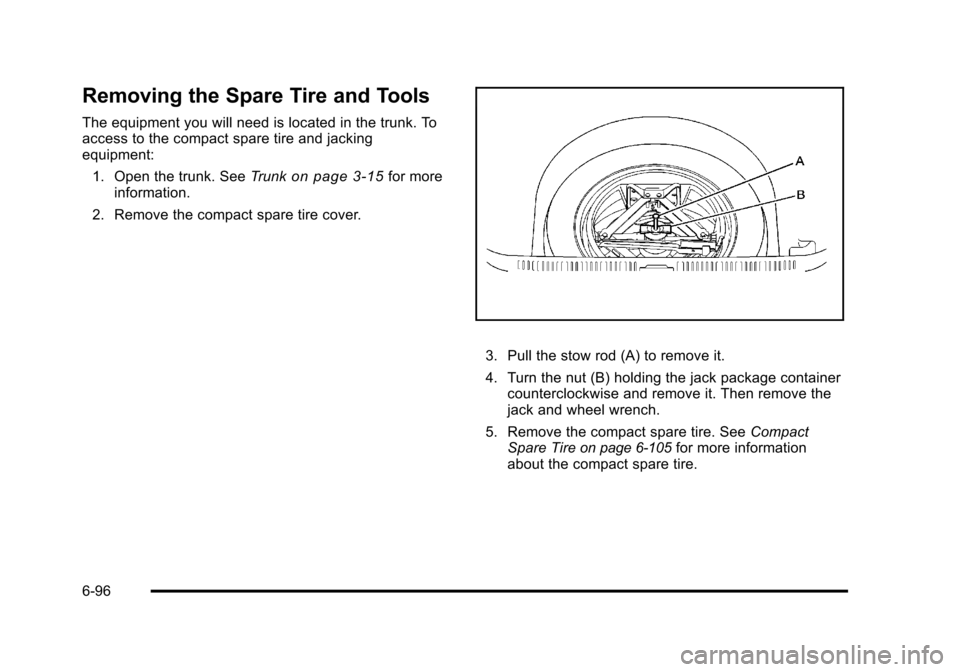
Black plate (96,1)Cadillac STS Owner Manual - 2011
Removing the Spare Tire and Tools
The equipment you will need is located in the trunk. To
access to the compact spare tire and jacking
equipment:1. Open the trunk. See Trunk
on page 3‑15for more
information.
2. Remove the compact spare tire cover.
3. Pull the stow rod (A) to remove it.
4. Turn the nut (B) holding the jack package container counterclockwise and remove it. Then remove the
jack and wheel wrench.
5. Remove the compact spare tire. See Compact
Spare Tire
on page 6‑105for more information
about the compact spare tire.
6-96
Page 447 of 528
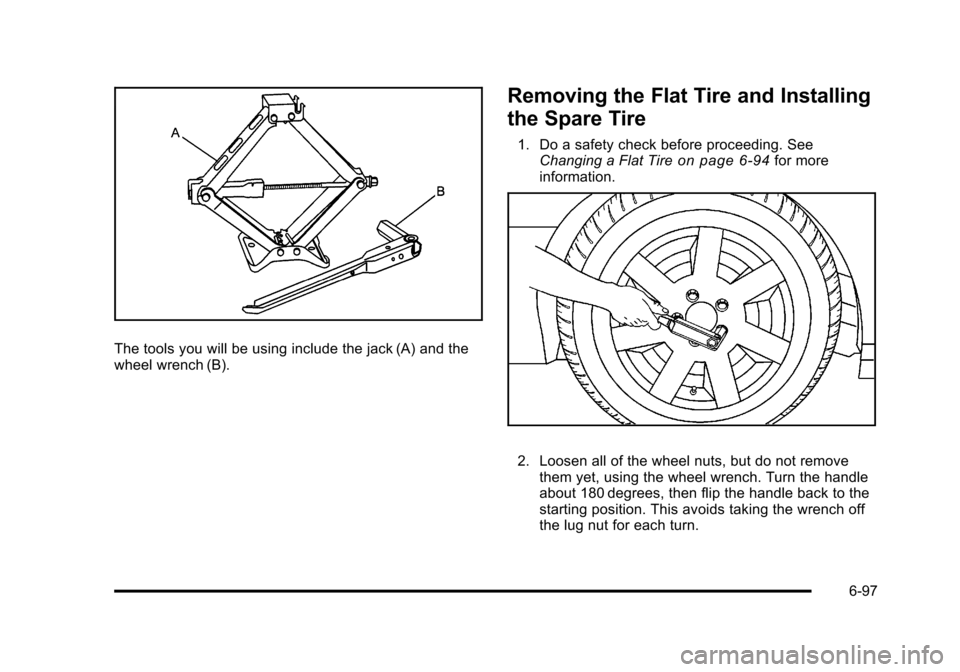
Black plate (97,1)Cadillac STS Owner Manual - 2011
The tools you will be using include the jack (A) and the
wheel wrench (B).
Removing the Flat Tire and Installing
the Spare Tire
1. Do a safety check before proceeding. SeeChanging a Flat Tireon page 6‑94for more
information.
2. Loosen all of the wheel nuts, but do not remove them yet, using the wheel wrench. Turn the handle
about 180 degrees, then flip the handle back to the
starting position. This avoids taking the wrench off
the lug nut for each turn.
6-97
Page 448 of 528
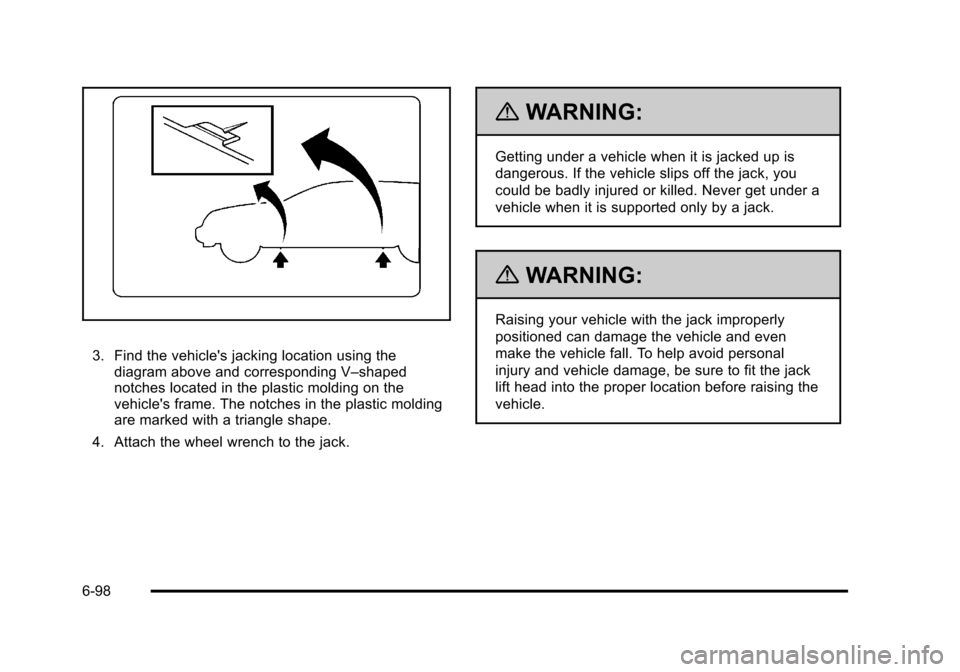
Black plate (98,1)Cadillac STS Owner Manual - 2011
3. Find the vehicle's jacking location using thediagram above and corresponding V–shaped
notches located in the plastic molding on the
vehicle's frame. The notches in the plastic molding
are marked with a triangle shape.
4. Attach the wheel wrench to the jack.
{WARNING:
Getting under a vehicle when it is jacked up is
dangerous. If the vehicle slips off the jack, you
could be badly injured or killed. Never get under a
vehicle when it is supported only by a jack.
{WARNING:
Raising your vehicle with the jack improperly
positioned can damage the vehicle and even
make the vehicle fall. To help avoid personal
injury and vehicle damage, be sure to fit the jack
lift head into the proper location before raising the
vehicle.
6-98
Page 449 of 528
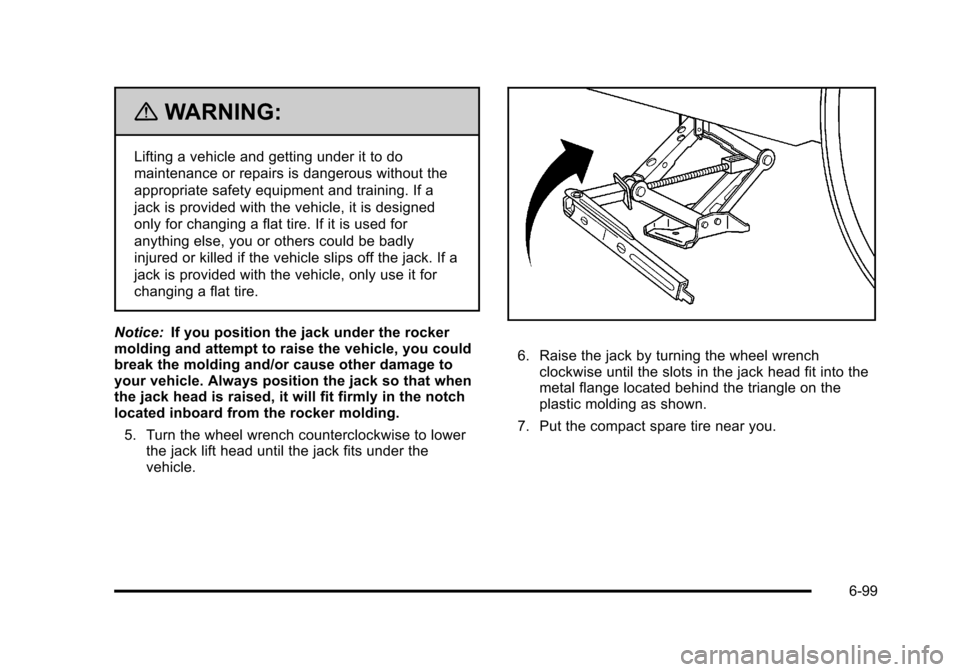
Black plate (99,1)Cadillac STS Owner Manual - 2011
{WARNING:
Lifting a vehicle and getting under it to do
maintenance or repairs is dangerous without the
appropriate safety equipment and training. If a
jack is provided with the vehicle, it is designed
only for changing a flat tire. If it is used for
anything else, you or others could be badly
injured or killed if the vehicle slips off the jack. If a
jack is provided with the vehicle, only use it for
changing a flat tire.
Notice: If you position the jack under the rocker
molding and attempt to raise the vehicle, you could
break the molding and/or cause other damage to
your vehicle. Always position the jack so that when
the jack head is raised, it will fit firmly in the notch
located inboard from the rocker molding.
5. Turn the wheel wrench counterclockwise to lower the jack lift head until the jack fits under the
vehicle.
6. Raise the jack by turning the wheel wrenchclockwise until the slots in the jack head fit into the
metal flange located behind the triangle on the
plastic molding as shown.
7. Put the compact spare tire near you.
6-99
Page 450 of 528

Black plate (100,1)Cadillac STS Owner Manual - 2011
8. Raise the vehicle by turning the wheel wrenchclockwise. Raise the vehicle far enough off the
ground for the compact spare tire to fit under the
vehicle.
9. Remove all the wheel
nuts and the flat tire.
{WARNING:
Rust or dirt on a wheel, or on the parts to which it
is fastened, can make wheel nuts become loose
after time. The wheel could come off and cause
an accident. When changing a wheel, remove any
rust or dirt from places where the wheel attaches
(Continued)
6-100